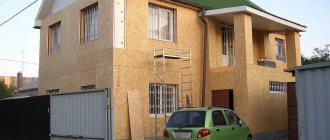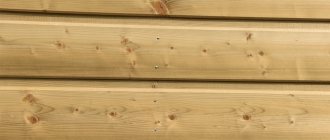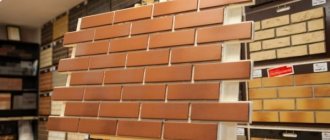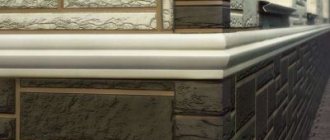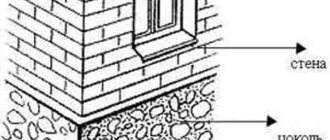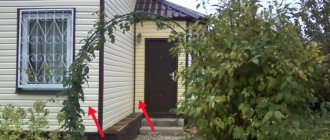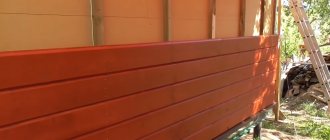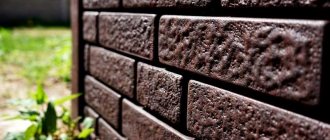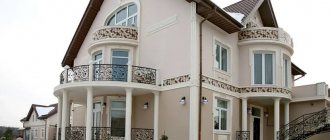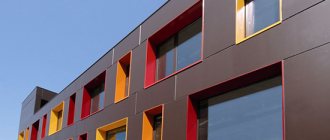Exterior finishing of wooden houses is an important stage of construction. Therefore, when finishing facades, panels imitating slate, brick, stone, and rock are used. Polymer sand panels for facades are used for finishing the facades of country houses.
Brick panels stand out colorfully among similar façade materials. On the outside of the home, brickwork is imitated, which is similar to the building material in reality. Bricks can have almost any shade of the red spectrum and have any texture. When compared with traditional decoration, it looks advantageous.
Artificial cladding protects and insulates the walls of a home. The plates protect against the cold due to the characteristics of the material or the use of an additional layer of insulation. This type of facade cladding has managed to win the preferences of many people, because this type of cladding panel gives the building a presentable appearance.
Why choose wall panels for exterior decoration of a house?
The development of the construction industry has given rise to the emergence of new modern materials for external cladding, characterized by excellent physical properties and reasonable prices. This is exactly what wall panels are, reducing the cost of building houses, extending its service life, and, at the same time, acting as a protective barrier from rain, snow, ultraviolet radiation, which negatively affects the surface of walls made from almost any building material.
Facade panels for exterior finishing of houses are widely used for treating the external surface of public buildings, private houses and cottages, shopping complexes, entertainment and sports centers, medical and educational institutions.
Wall panels have the following advantages:
- strength;
- frost resistance;
- soundproofing;
- long service life;
- a light weight;
- environmental friendliness;
- affordable price;
- variety of types, textures and colors.
- do not fade in the sun and do not lose color from rain;
- do not require special care or treatment;
- do not rot, are not attractive to insects and rodents;
House finished with facade slabs Source domcom.ru
Cladding panels for the facade of a house are suitable not only for new buildings, but also for finishing old buildings, regardless of the material of the building.
See also: Catalog of companies that specialize in facade and finishing materials.
Decorative slabs for exterior wall decoration are divided into several types, according to material and design:
- Sandwich panels. They consist of several layers of materials glued together. Each layer has different characteristics. The top one is a galvanized metal coating and has a protective function, and the bottom one acts as insulation.
- Composite panels. They are made on a cement base with a fiber filler or a thin layer of metal. This material protects walls well from external environmental influences that contribute to their destruction.
- Plates made of polyvinyl chloride and pressed wood pulp, externally made to look like wood, stone or brick.
Decorative panels for the external walls of a house, belonging to any of these categories, do not put pressure on the load-bearing walls of the building and the foundation.
Installing the entire house with facade slabs does not take much time. The work is completed within a period of two days to two weeks, depending on the area of the facade.
Decorating the wall of a house with facade slabs Source recon-stroi.ru
Composites
This category includes fiber cement, porcelain stoneware, clinker and aluminum composite facade panels. The most popular are fiber cement.
Facades made of fiber cement panels can imitate the surface of wood, stone, marble or brick
Porcelain stoneware products are durable, resistant to moisture and ultraviolet radiation. They look solid and attractive and are easy to clean. As for aluminum composite panels, they are not cheap, but they are very durable and resistant to various kinds of negative influences. They consist of 2 sheets of aluminum separated by a polymer layer.
Porcelain stoneware facade panels Mayor Ceramic
Clinker panels can have a thermal insulation layer, the thickness of which reaches 80 mm. They weigh a lot, which makes installation difficult. Can be:
- self-supporting (large solid blocks with openings for windows and doors);
- decorative (used to decorate insulated walls, do not have a heat-insulating layer);
- insulated.
Clinker for finishing facades
Clinker looks beautiful, is durable, environmentally friendly, easy to repair and maintain. Often used for finishing industrial facilities, garages, and plinths.
Fiber cement panels are characterized by the presence of special polymer fibers in their composition. They are not cheap and have a long service life. They increase the level of noise and heat insulation of the building and protect against severe frosts.
Application of fiber cement panels
Note! Fiber cement products invented in Japan can be used in all regions of the country.
You can install them yourself; there is nothing complicated here. However, the weight of the panel is significant and it is easy to drop it and damage it. It is also worth mentioning the environmental friendliness of the material - the slats do not emit any harmful substances into the air when heated.
Fiber cement panels
Finally, such panels can be mounted on any base.
Façade panel options
Panels for the facade of a house are classified according to several characteristics:
- in shape - rectangular, narrow elongated panels or a medium-sized module;
- according to texture - like stone, brick, wood, for painting;
- by the presence of thermal insulation - with or without insulation;
- according to the method of fastening - panels with a locking mechanism or those that do not require fixation with each other;
- by material - composite, polymers, metal, glass.
Metal
They can be made of aluminum or galvanized stainless steel with a polymer coating. They are not subject to corrosion, are not afraid of moisture, do not burn, and are easy to install. The main disadvantage is the lack of thermal insulation capabilities, as well as susceptibility to deformation.
Metal siding to look like wood Source 2gis.ru
Polymer
Polymer or PVC panels are the cheapest and most popular option for facade finishing. They have a wide range of colors and are also available in versions that imitate natural materials. Plastic panels for home decoration are very light and easy to install, in addition, they have a long shelf life.
Ventilated facades "Turnkey"
| Name | Without insulation | 50mm | 100mm |
| - professional sheet | 2215 | 2500 | 2610 |
| - metal siding | 2715 | 3000 | 3110 |
| - porcelain stoneware | 3045 | 3330 | 3440 |
| - fake diamond | 3045 | 3330 | 3440 |
| - marmorok | 3045 | 3330 | 3440 |
| — fiber cement boards | 3175 | 3460 | 3570 |
| - metal cassettes | 3415 | 3700 | 3810 |
| - composite panels | 3520 | 3805 | 3915 |
| - planken | 4815 | 5100 | 5210 |
| - clinker tiles | 5245 | 5530 | 5640 |
| - aluminum cassettes | 5440 | 5725 | 6835 |
| — HPL panels | 6860 | 7145 | 7255 |
| – terracotta panels | 7815 | 8100 | 8210 |
| - lamellas | 9215 | 9500 | 9610 |
Video description
In our video we will talk about Japanese facades. Let's take a closer look at what errors happen during the installation process:
Brick panels
Brick decoration of the external walls of a house has remained popular for many years; it gives the house an expensive look and a special zest. But at the same time, it requires certain costs; in addition to purchasing the material itself, it is necessary to purchase a solution and pay for the work of the master. But in the modern building materials market, an excellent, cheaper alternative to brick finishing has appeared - brick-look wall panels.
The characteristics of such panels are not inferior to natural brick, and in appearance they are almost no different from it. The structure can be homogeneous or combined (equipped with insulation).
Glass panels
An excellent modern material, which is rarely used to decorate private homes - glass panels are mainly used to decorate office buildings. The material includes fiberglass - tempered, reinforced or laminated. The strength of the coating depends on the processing method. A good option for insulating a house, because such panels accumulate part of the thermal energy of the sun.
Exterior Wall Panels for Home
On a note! Remember that glass panels are purely decorative material that does not strengthen the building in any way or increase its strength.
The peculiarity of glass panels is that they are perfectly combined with other coatings, including wood, metal, and concrete. They also allow you to implement any design solution, but installing them is quite difficult.
Stone-like glass on the façade
Pros and cons of facing slabs
The advantages and disadvantages of different types of facade panels are presented in the table:
| Type of panels | pros | Minuses |
| Metal | low weight; affordable price; fire resistance; durability and strength. | the need to hire workers for installation; poor thermal insulation. |
| PVC | moisture resistance; frost resistance; ease of installation; resistance to environmental influences; environmental friendliness; low cost; wide range of colors; durability. | flammability; toxicity when burning; fragility. |
| Fiber cement | long service life; heat resistance; not subject to rotting and corrosion; | high moisture absorption (absorb up to 10% moisture from the air); subject to deformation; low impact resistance. |
| Clinker | moisture resistance; environmental friendliness; strength; low weight; variety of textures and colors. | surface preparation required before installation; high price; Vapor tightness (requires leaving space between the panel and the wall). |
| Sandwich panels | operation over 30 years; fire safety do not rot or rust; environmental friendliness; thermal insulation; strength; moisture resistance | require care during transportation and installation; freeze at temperatures from -200 C. |
| Glass | original design; good heat and sound insulation; absorption of UV rays. | low installation speed; high price. |
Technical specifications
Modern plastic products differ from the first releases in increased endurance and long service life. Cracks can only form if there is a significant deviation from operating standards. Plastic facade panels have the following technical characteristics:
- weight 1.5-2 kg/panel;
- the thickness of the products can be 0.7-1.2 mm;
- width 1300 and 1850 mm;
- length 2500-3800 mm;
- permissible tensile strength 100 MPa;
- thermal expansion 0.15%;
- thermal conductivity is 0.3 w/m*k;
- bending strength parameter 140 MPa;
- density 1.4 g/cc.
- resistance to temperature changes depends on the raw material, within -50℃.. +85℃.
There are no Russian regulations regarding the production of vinyl panels. There is an international standard developed by the American organization ASTM (American Society for Testing and Materials). Foreign and domestic companies are guided by these recommended optimal characteristics.
The thickness of panels whose service life exceeds 10 years, according to AST recommendations, should be 0.9-1.2 mm, and their tensile strength should be 422 kg/sq.cm. If plastic panels bear the ASTM mark, this means that the product is of high quality.
What to look for when choosing
The facade must have a long service life, be functional and resistant to many negative factors. That is why you should be responsible when choosing wall panels for the facade of a house.
When choosing a material, you should pay attention to the following aspects:
- There is a need for thermal insulation . If the walls of the building require additional insulation, it is optimal to choose panels with insulation. In this case, two problems will be solved with one material.
- Environmental conditions. For example, in case of high humidity, you should avoid those types that have a high level of moisture absorption, and for regions with a lot of sunny days, you should not choose panels that are likely to fade in the sun.
- Also, you should take into account the thickness of the walls of the building and its age .
Original house decorated with facade slabs Source prorab.guru
Manufacturers
Tiles for facades are produced by many companies, including:
- Polysand. Offers high-quality and reliable polymer material. The price per square meter is about a thousand rubles.
- Hardplast. At a good price you can purchase reliable panels that imitate broken stone, wild stone and tiles with a smooth surface. The cost is 59 rubles/piece.
- Alta profile. The company offers strong and durable panels at a price of 560 rubles per piece. The collection includes slabs that imitate natural stones.
Modern manufacturers offer a variety of options in both color and texture. Therefore, buying this option in Moscow will not be difficult. Polymer panels for facades are an excellent alternative to classic coatings. The service life of the material is thirty years. The panels do not require any special care or maintenance.
Installation features
Installation of panels for facade cladding requires preliminary preparation of the walls. The walls need to be cleaned of old finishes, dirt and dust, then treated with a layer of primer and a special compound.
Next, if necessary, the sheathing is installed. The facing frame is assembled from a thin metal profile or wooden slats. The frame needs to be treated with an anti-rust and rotting compound.
The lathing will provide additional thermal insulation; in addition, the walls will be ventilated, which will maintain a comfortable temperature in the room.
Then, the panels are attached to the supporting frame with nails, dowels or screws. In the absence of sheathing, the plates are simply glued to the wall with a special compound.
Clinker thermal panels
Insulation and facing layer form the basis of such panels. They are connected by special grooves around the perimeter. Mounting sleeves are provided for mounting to walls. Using polystyrene foam or polyurethane foam as insulation. Simple installation plus reliable fastening.
Such panels use grooves and tenons, which guarantee a monolithic installation. Over the course of a decade, they have deservedly come out ahead thanks to their long service life and excellent appearance. Clinker panels for facades reduce the costs used to heat houses by sixty percent.
Materials with wood fibers
Quite inexpensive and high-quality building materials are a multi-layer structure made from wood fibers.
To protect them from moisture, they are coated with a layer of paint, while they are quite easy to process and install by installing an aluminum sheathing made of building profiles, which will provide additional thermal insulation.
Polymer coated
These finishes are made from galvanized metal, which determines their high wear resistance and affordable cost.
The protective and decorative polymer layer is painted at the application stage, so such materials are offered in a fairly wide variety of colors, which helps decorate the building.
